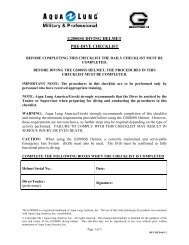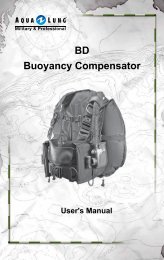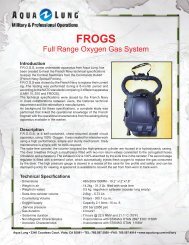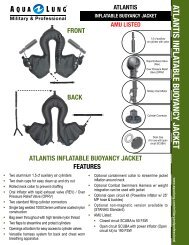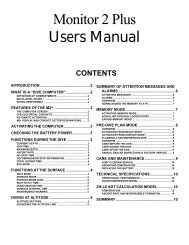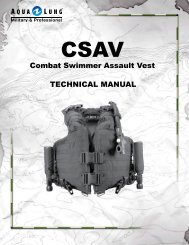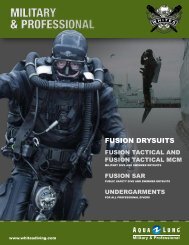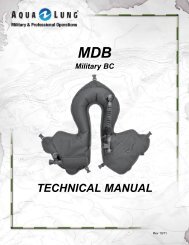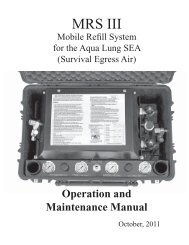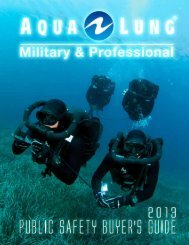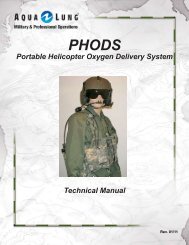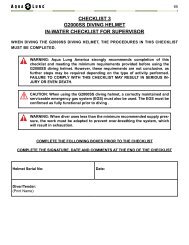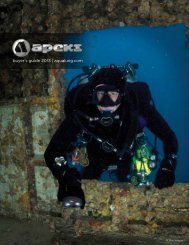latitude xlt buoyancy compensator owner's manual - Aqua Lung
latitude xlt buoyancy compensator owner's manual - Aqua Lung
latitude xlt buoyancy compensator owner's manual - Aqua Lung
You also want an ePaper? Increase the reach of your titles
YUMPU automatically turns print PDFs into web optimized ePapers that Google loves.
<strong>latitude</strong> <strong>xlt</strong><br />
<strong>buoyancy</strong> <strong>compensator</strong><br />
owner’s <strong>manual</strong>
Latitude XLT BC Owner’s Manual<br />
Copyright Notice<br />
This <strong>manual</strong> is copyrighted, all rights reserved. It may not,<br />
in whole or in part, be copied, photocopied, reproduced,<br />
translated or reduced to any electronic medium or machinereadable<br />
form without prior consent in writing from <strong>Aqua</strong><br />
<strong>Lung</strong> International. It may not be distributed through the<br />
internet or computer bulletin board systems without prior<br />
consent in writing from <strong>Aqua</strong> <strong>Lung</strong> International.<br />
©2006 <strong>Aqua</strong> <strong>Lung</strong> International<br />
Latitude XLT BC Owner’s Manual<br />
pn 18349 rev. 9/06<br />
Warnings, Cautions, & Notes<br />
Pay special attention to information provided in warnings,<br />
cautions and notes that are accompanied by one of these<br />
symbols:<br />
WARNINGS indicate a procedure or situation that<br />
may result in serious injury or death if instructions<br />
are not followed correctly.<br />
CAUTIONS indicate any situation or technique<br />
that will result in potential damage to the<br />
product, or render the product unsafe if<br />
instructions are not followed correctly.<br />
NOTES are used to emphasize important<br />
points,tips and reminders.<br />
WARNING: This <strong>manual</strong> provides essential instruction for the<br />
proper fitting, adjustment, inspection and care of your new BC.<br />
Because <strong>Aqua</strong> <strong>Lung</strong> BC’s utilize patented technology, it is very<br />
important to take the time to read these instruction in order to<br />
understand and fully enjoy the features that are unique to your<br />
specific model. Improper use of this BC could result in serious<br />
injury or death.
CONTENTS<br />
Latitude XLT BC Owner’s Manual<br />
SAFETY INFORMATION 3<br />
General Precautions & Warnings 3<br />
BASIC SETUP 5<br />
Attaching the MP Hose to the First Stage 5<br />
Securing the BC to the Cylinder 6<br />
Threading the Cylinder Band 8<br />
Waistband Adjustment 9<br />
WEIGHT INTEGRATION FEATURE 10<br />
Weight System - Setup & Installation 10<br />
Loading the Weight Pouches 0<br />
Weight Pouch Installation<br />
Releasing the Weight Pouches 3<br />
Non-releasable Weight 3<br />
DONNING & ADJUSTMENT PROCEDURES 15<br />
INFLATION METHODS 16<br />
Oral Inflation 6<br />
Power Inflation 6<br />
DEFLATION METHODS 17<br />
Deflation via Oral Inflator 7<br />
Deflation via Dual Exhaust Valve 7<br />
Overpressure Relief (OPR)/Dump Valve 8<br />
SPECIAL FEATURES 19<br />
Knife Attachment 9<br />
Chest Strap Attachment 9<br />
Dump Valve Conversion Kit 0<br />
Octo Pocket 0<br />
PREDIVE INSPECTION 21<br />
POSTDIVE CARE & MAINTENANCE 22<br />
DEALER INSPECTION & SERVICE 23<br />
SERVICE RECORD 24<br />
WARRANTY INFORMATION 25
SAFETY INFORMATION<br />
General Precautions & Warnings<br />
Latitude XLT BC Owner’s Manual 3<br />
Before using this <strong>buoyancy</strong> <strong>compensator</strong> (BC), you must receive instruction<br />
and certification in SCUBA diving and <strong>buoyancy</strong> control from a recognized<br />
training agency. Use of SCUBA equipment by uncertified or untrained<br />
persons is dangerous and can result in injury or death.<br />
Read this owner’s <strong>manual</strong> completely before attempting to use your<br />
BC, and become familiar with it first in a controlled environment such<br />
as a swimming pool, in order to weight yourself properly and to become<br />
comfortable with using its many features and adjustments.<br />
Before every dive, perform a complete pre-dive inspection according to<br />
the procedure prescribed in this <strong>manual</strong>, to ensure that all components<br />
are functioning properly and no signs of damage or leaks are present. If<br />
you find that your BC is not functioning properly or is damaged, remove it<br />
from service until it can be repaired by an authorized <strong>Aqua</strong> <strong>Lung</strong>/SeaQuest<br />
Dealer.<br />
Your BC is not a lift bag. DO NOT use it to bring heavy objects to the<br />
surface. Doing so may cause permanent damage to the BC, and could<br />
also result in serious injury or death due to embolism or decompression<br />
sickness.<br />
In an emergency such as an out of air situation or uncontrolled descent, it<br />
is important to remove and jettison weight immediately. DO NOT depend<br />
solely on using your BC’s power inflator to lift you to the surface.<br />
In the event of an uncontrolled, rapid ascent, it is important to immediately<br />
begin venting air from the BC. Continue venting air to slow your ascent rate<br />
if neutral <strong>buoyancy</strong> cannot be reestablished.<br />
DO NOT inhale from your oral inflator. The BC may contain harmful<br />
contaminants or gasses, which could cause suffocation or injury.<br />
Factory prescribed service for this BC must be performed at least once<br />
annually by a factory trained technician who is employed by an authorized<br />
<strong>Aqua</strong> <strong>Lung</strong>/SeaQuest Dealer. Annual service consists of a complete<br />
overhaul of the power inflator, and a general air leak inspection of the<br />
bladder and valve connections.<br />
Disassembly, repair, or lubrication must not be attempted by persons<br />
who are not factory trained and authorized by <strong>Aqua</strong> <strong>Lung</strong>/SeaQuest.<br />
Unauthorized service will render the warranty null and void.<br />
This BC is designed for use with compressed air or Nitrox/EAN (enriched<br />
air nitrox) mixtures not exceeding 40% oxygen. Any use of gas mixtures<br />
with increased oxygen content or the addition of helium or other<br />
substances may cause corrosion, deterioration and/or premature aging<br />
of the BC leading to component failure of the metal and rubber parts.<br />
The component failures could lead to a loss of <strong>buoyancy</strong> control and/or<br />
pressure integrity of the BC resulting in injury or death. Non-standard<br />
breathing mixtures may also present a risk of fire or explosion. The use<br />
of Nitrox/EAN requires additional training. Failure to observe this warning<br />
may result in injury or death. Use only nitrogen/oxygen mixtures containing<br />
no more than 40% oxygen.
4 Latitude XLT BC Owner’s Manual<br />
WARNING: A <strong>buoyancy</strong> <strong>compensator</strong> (BC) is NOT a life jacket! It<br />
is not designed to provide face-up flotation in all situations;<br />
therefore it does not meet U.S. Coast Guard regulations for a<br />
life preserver or personal flotation device (PFD). If you become<br />
unconscious in the water without a buddy present to immediately<br />
give assistance, you may suffer serious injury or death from<br />
drowning.<br />
Your <strong>buoyancy</strong> <strong>compensator</strong> is primarily designed to help you<br />
maintain neutral <strong>buoyancy</strong> while in a comfortably balanced,<br />
face-down swimming position underwater. It is also designed<br />
to provide you with flotation so that you can rest on the<br />
surface, but it is not designed to function as a life preserver<br />
or personal flotation device (PFD). In order to meet U.S.<br />
Coast Guard regulations, a PFD must be designed so that<br />
it automatically rights you to a face-up position and holds<br />
your head out of the water on the surface. The design<br />
characteristics of a personal flotation device are different<br />
from those of a <strong>buoyancy</strong> <strong>compensator</strong>. The ability of any<br />
flotation device to float you in a face-up position can also<br />
be affected by other diving equipment you wear, including<br />
a cylinder, weight or exposure suit, and whether it can be<br />
inflated before you lose consciousness.<br />
For this reason, it is important to always dive with a buddy,<br />
and maintain close proximity with them at all times. Do not<br />
depend on any flotation device to hold your face above the<br />
surface in the event that you are rendered unconscious in the<br />
water while diving.<br />
WARNING: Although this <strong>manual</strong> provides some basic guidelines<br />
for certain <strong>buoyancy</strong> control techniques, it is not a substitute for<br />
training from a professional diving instructor. Failure to weight<br />
yourself properly may create a hazardous condition that could<br />
lead to serious injury or death. If you are unsure how to weight<br />
yourself in order to achieve optimum <strong>buoyancy</strong> underwater and<br />
on the surface, do not dive until you have obtained the necessary<br />
instruction from your diving instructor or an authorized <strong>Aqua</strong><br />
<strong>Lung</strong>/SeaQuest Dealer.<br />
If you have any questions regarding your Buoyancy Compensator or<br />
these instructions, contact your local dealer or <strong>Aqua</strong> <strong>Lung</strong>/SeaQuest at:<br />
(760) 597-5000
Latitude XLT BC Owner’s Manual 5<br />
Note: The terms “hook”,“loop” and “hook & loop” are used throughout<br />
this <strong>manual</strong>. Hook & Loop is commonly known as Velcro®,<br />
which is a trademarked brand of hook & loop. Many of the BC’s<br />
components have hook & loop attachments, including the waistband,<br />
cylinder bands, and weight pouch flaps.<br />
BASIC SETUP<br />
<strong>Aqua</strong> <strong>Lung</strong> / SeaQuest recommends that you bring your<br />
<strong>buoyancy</strong> <strong>compensator</strong>, together with your regulator, to your<br />
authorized dealer for the installation of the MP inflator hose and<br />
other accessories. The retailer can also answer any questions<br />
you may have pertaining to the information in this <strong>manual</strong>.<br />
If it is not possible to return the BC with your regulator to your<br />
authorized dealer, you may install the MP quick disconnect<br />
inflator hose by carefully performing the steps in the following<br />
procedure.<br />
Attaching the MP Hose to the First Stage<br />
WARNING: DO NOT connect the inflator hose to a high pressure (HP)<br />
port (greater than 200 psi / 14 bar). This may cause the hose to burst<br />
when pressurized, which can result in serious injury. If you are unsure<br />
which regulator port is medium pressure (MP) or high pressure<br />
(HP), consult your regulator owner’s <strong>manual</strong> or your dealer before<br />
attaching the hose.<br />
. Remove the port plug<br />
from a MP port on the<br />
regulator using an appropriately<br />
sized wrench.<br />
1. Remove the inflator hose from the<br />
power inflator body by gripping the<br />
grooved sleeve over the quick disconnect<br />
coupling with your thumb and<br />
forefinger and sliding the sleeve back.
6 Latitude XLT BC Owner’s Manual<br />
Securing the BC to the Cylinder<br />
3. Check to ensure the o-ring is<br />
present and in good condition,<br />
and screw the threaded end of<br />
the hose into the port. Tighten to<br />
40 in/lbs (46 kg/cm) with a 9/16"<br />
wrench.<br />
Note: BC cylinder bands adjust for all standard cylinder diameters:<br />
6.9" (17.5 cm), 7.25" (18.5 cm), and 8.0" (20.3 cm). The cylinder<br />
bands are properly threaded to the buckles when the BC leaves<br />
the factory. If rethreading is necessary, follow the procedure in the<br />
next section: Threading the Cylinder Band.<br />
. Wet the cylinder band and then slide it<br />
over the cylinder so that the BC is at the<br />
desired position in relation to the cylinder<br />
valve. Make sure the cylinder valve air<br />
outlet is facing the back of the BC.<br />
. Remove the free end of the<br />
cylinder band from outer slot on<br />
the buckle.<br />
3. While holding the cylinder secure,<br />
pull the free end of the cylinder band<br />
until there is a very tight fit between<br />
the pack and the cylinder.
Latitude XLT BC Owner’s Manual 7<br />
4. Close the buckle halfway to<br />
hold the cylinder band taut, and<br />
thread the free end of the band<br />
through the open slot in the end<br />
of the buckle.<br />
5. Pull the cam buckle closed so that it lies flat<br />
against the cylinder. Secure the end of the cylinder<br />
band with the hook & loop attachment.<br />
6. Test the tightness by pushing/pulling the back<br />
frame and cradle.<br />
WARNING: The cylinder band will initially stretch as it becomes<br />
wet. Always wet the band before making the final adjustment; apply<br />
enough tension to ensure that the cylinder is completely secure. Test<br />
this connection before every dive. If the cylinder slips free from the<br />
BC during the dive, you may lose your air supply, which could lead<br />
to serious injury or death.
8 Latitude XLT BC Owner’s Manual<br />
Threading the Cylinder Band<br />
Step 1: Firmly grasp the metal<br />
D-ring with your left hand.<br />
Step 2: While firmly holding the<br />
metal D-ring, rotate the buckle<br />
back towards the webbing. The<br />
buckle should form and angle with<br />
the metal D-ring as shown in the<br />
top view.<br />
Step 4: Insert band<br />
through the inside slot.<br />
TOP VIEW<br />
Step 3: Insert band through<br />
the metal D-ring, then<br />
through the middle slot.<br />
Step 5: Insert band<br />
through the outer slot.
Latitude XLT BC Owner’s Manual 9<br />
NOTE: This final threading step is done when the BC is secured<br />
to the cylinder (refer to step 4, p. 7). Close the buckle halfway to<br />
prevent the webbing from slipping and thread the free end of the<br />
band through the open slot in the end of the buckle.<br />
The Latitude XLT is designed to be a recreational BC. It is<br />
not designed to be used with double cylinders.<br />
WARNING: DO NOT use double cylinders with the Latitude XLT BC.<br />
When fully charged and worn together as doubles, some cylinders<br />
may create enough negative <strong>buoyancy</strong> to counteract the amount of<br />
lift your BC can provide. At depth, this can lead to a dangerous situation<br />
if your wetsuit becomes compressed and you can no longer<br />
achieve positive <strong>buoyancy</strong> by jettisoning weight.<br />
Waistband Adjustment<br />
. Lay your Latitude XLT so that the front of the BC is facing<br />
you. Disconnect the waistband buckle, waistband, chest<br />
strap and shoulder buckles so you have open access to the<br />
backpack.<br />
. For each side of the waistband, detach the hook & loop<br />
and adjust to the desired length, then resecure the hook<br />
& loop. The hook & loop must overlap a minimum of four<br />
inches, but not extend past the end of the loop.<br />
3. The waist strap length can also be adjusted by pulling the<br />
webbing through the tri glide at the mounting point on the<br />
backpack.
0 Latitude XLT BC Owner’s Manual<br />
WEIGHT INTEGRATION FEATURES<br />
The Latitude XLT features the SureLock (SL) weight<br />
system. With the SureLock system, weight pouches are<br />
secured with a mechanical locking mechanism, as opposed<br />
to a hook & loop attachment used on other models. The<br />
SureLock weight system either supplements or replaces a<br />
conventional weight belt. This unique feature allows you to<br />
quickly jettison either one or both of two weight pouches in<br />
the event of an emergency, thereby maintaining better control<br />
over your rate of ascent. The weight pouches can be easily<br />
reloaded into their respective holsters while you are wearing<br />
the BC. This makes the BC much easier to don than other<br />
weight-integrated BC’s that must be fully loaded with weight<br />
prior to donning.<br />
It is very important to read the following instructions, and become<br />
thoroughly familiar with the correct methods for installing<br />
and releasing weight before you dive with your BC.<br />
Weight System - Setup & Installation<br />
The weight system features two interchangeable weight<br />
pouches which can be filled with either block weights or<br />
“soft weight” (pouches containing lead shot), in increments<br />
of 5 pounds or less. For ease of operation, low-profile block<br />
weight is strongly recommended. Each weight pouch can<br />
hold a maximum of 10 lbs/4.5 kg (20 lbs/9 kg total). The<br />
Large and X Large can hold a maximum of 16 lbs/7.25 kg<br />
(32 lbs/14.5 kg).<br />
Loading the Weight Pouches<br />
<strong>Aqua</strong> <strong>Lung</strong>/SeaQuest recommends that each pouch is loaded<br />
with equal amounts of weight for optimum balance; this will<br />
prevent the tendency to roll to one side during the dive. Also, it<br />
is strongly recommended that each weight pouch is fully loaded<br />
with two separate weight blocks for the standard pouch, or four<br />
separate blocks for the large pouch. For example, if you want<br />
to load a standard pouch with 6 pounds, use two separate 3<br />
pound weights.<br />
. If the weight pouches are installed in the BC, remove<br />
them by firmly pulling the release handle toward the<br />
center of the waistband (see p. 3, Releasing Weight<br />
Pouches).<br />
NOTE: The weight pouches are specially pre-formed to fit the<br />
contour of your waist. Do not attempt to bend or straighten a<br />
pre-formed pouch.
Fig. 1<br />
Latitude XLT BC Owner’s Manual<br />
2. Lift up each pouch’s flap (Fig 1a), and lay it back over the<br />
handle (Fig b). While holding the pouch fully open, insert<br />
the weight and then close the flap. When each pouch has<br />
been loaded with weight, firmly run your hand over the flaps<br />
to securely fasten the hook & loop (Fig c).<br />
c<br />
a<br />
b
Latitude XLT BC Owner’s Manual<br />
Surelock Weight Pouch Installation<br />
CAUTION: <strong>Aqua</strong> <strong>Lung</strong>/SeaQuest strongly recommends that you do not<br />
attempt to don your BC when it is fully loaded with weight. You may<br />
otherwise risk injury due to muscle strain or a temporary loss of balance.<br />
The pouches are installed with the smooth panel facing<br />
outward (pouch flap facing toward the BC).<br />
To install either pouch, grasp the D-ring or lobe in front of<br />
the female SureLock receptacle with your opposite hand<br />
and slide the closed end of the pouch into the opening of<br />
the holster. Insert the male portion of the SureLock buckle<br />
(a) into the female receptacle (b) on the BC until you can<br />
hear/feel it click into place.<br />
b<br />
a<br />
WARNING: Before every dive, it is important to make sure each weight<br />
pouch is secure, in order to prevent the pouches from falling out.<br />
Involuntary release of both weight pouches underwater can cause a<br />
sudden increase in <strong>buoyancy</strong> causing a rapid ascent, which could lead<br />
to serious injury or death due to arterial gas embolism, decompression<br />
sickness, or drowning.
Latitude XLT BC Owner’s Manual 3<br />
Releasing Weight Pouches<br />
Unlike a weight belt, which has only one release mechanism,<br />
each weight pouch is connected to the BC independently<br />
of the other and must be released separately. This<br />
provides you with the option of being able to jettison one<br />
pouch at a time, thereby maintaining better control of your<br />
ascent rate in an emergency.<br />
In the event that you need to jettison weight, simply pull<br />
the release handle of each pouch towards the center of the<br />
waist buckle. When the pouch is completely disengaged<br />
from its holster, hold it out and away from your body before<br />
dropping it.<br />
WARNING: Ensure that your weight pouches are not obstructed by<br />
any straps, lines, etc. DO NOT add weight to the BC’s pockets, as<br />
this may interfere with the removal of the pouches in an emergency.<br />
Failure to ditch weight in an emergency may lead to serious injury or<br />
death due to drowning.<br />
WARNING: To avoid injuring other divers, always look below you<br />
before dropping weight.<br />
Note: In addition to becoming familiar with the weight system yourself,<br />
it is very important to explain its function to your dive buddy so that<br />
he/she is equally familiar with it.
14 Latitude XLT BC Owner’s Manual<br />
Non-releasable Weight<br />
To supplement the releasable weight, the Latitude XLT is<br />
designed to carry non-releaseable weight in two fixed pockets<br />
located on each side of the cylinder band of the BC. The<br />
maximum amount of weight that each pocket can hold<br />
depends on the BC size. Refer to the chart below:<br />
BC Size Max Wt. Each Pocket Max Wt. Total<br />
XS Not available Not available<br />
Sm 3 lbs / .5 kg 6 lbs / 3 kg<br />
Med 5 lbs / .5 kg 0 lbs / 5 kg<br />
ML 5 lbs / .5 kg 0 lbs / 5 kg<br />
Lg 5 lbs / .5 kg 0 lbs / 5 kg<br />
XL 5 lbs / .5 kg 0 lbs / 5 kg<br />
To install weight into the non-releasable weight pockets,<br />
simply disconnect the flap buckle, slide in the weight block,<br />
fold the flap over the pocket, and reconnect the buckle.<br />
The non-releasable weight pockets are designed to hold<br />
single rectangular weight blocks. <strong>Aqua</strong> <strong>Lung</strong>/SeaQuest<br />
strongly advises against using small bullet-shaped weights<br />
and shot weight.<br />
Because the weight is non-releasable, it must not be used<br />
as your primary source of ballast. After filling the fixed<br />
pockets with weight, it is extremely important to check your<br />
<strong>buoyancy</strong> in the water while wearing the BC attached to a<br />
fully charged cylinder and your exposure suit. While standing<br />
in chest-deep water, deflate the BC completely and<br />
check to ensure that you can easily achieve positive <strong>buoyancy</strong><br />
by jettisoning your releasable weight.
Latitude XLT BC Owner’s Manual 5<br />
WARNING: The non-releasable weight pockets are intended strictly<br />
for containing non-releasable weight, used in addition to releasable<br />
weight. Do not fill either pocket with weight unless you are certain<br />
you can achieve positive <strong>buoyancy</strong> at depth by releasing your weight<br />
pouches or weight belt while your BC is completely deflated.<br />
DONNING & ADJUSTMENT PROCEDURES<br />
. Remove the weight pouches from the BC.<br />
. Disconnect the waist buckle and waistband.<br />
3. Ensure that the quick release buckles on both torso<br />
straps are securely fastened. While firmly holding the<br />
torso strap where it connects to the BC lobe, fully extend<br />
each torso strap to its maximum length by pushing<br />
straight up on the slide buckle.<br />
4. While your dive buddy lifts and holds the BC/cylinder<br />
behind you, place your arms through the BC torso straps<br />
as if you were putting on a jacket.<br />
5. While your buddy continues to hold the cylinder, connect<br />
the waistband and waist buckle. The weight of the<br />
cylinder should rest on the lumbar region (lower part) of<br />
your back.<br />
6. Connect the chest strap buckle. Pull on the free end of<br />
the strap to tighten. The chest strap should feel comfort<br />
able across the chest; it should not be overtightened so<br />
that it feels restrictive.<br />
7. After your buddy has released the cylinder and the BC<br />
feels comfortably supported on your hips and shoulders,<br />
bend forward at the waist and adjust the torso straps to<br />
a comfortable length by pulling on the torso strap<br />
D-rings.<br />
NOTE: Adjusting the shoulder straps too tightly will transfer the<br />
cylinder weight from the hips to the shoulders, restricting your arm<br />
movement and decreasing comfort.<br />
8. If necessary, readjust the waistband and waist buckle so<br />
that they are comfortably snug, but not restricting.
6 Latitude XLT BC Owner’s Manual<br />
INFLATION METHODS<br />
Oral Inflation<br />
To orally inflate your BC, place your<br />
lips on the oral inflator mouthpiece<br />
(a) and exhale a small amount of<br />
air into the mouthpiece to purge<br />
any water that may still be in the<br />
housing. While continuing to exhale<br />
into the mouthpiece, depress the oral<br />
inflator button (b) to inflate the BC.<br />
Immediately after exhaling, release<br />
the oral inflator button to prevent air<br />
from escaping.<br />
Power Inflation<br />
For the power inflator to operate, the<br />
MP inflator hose must be connected. To<br />
connect the MP hose, grip the grooved<br />
sleeve at the connection fitting with<br />
your thumb and forefinger, and slide<br />
the sleeve back. Place the fitting over<br />
the quick disconnect plug (c), and<br />
firmly push inward while releasing<br />
the sleeve. Check to ensure that the<br />
hose is securely attached. After the<br />
hose is attached to the power inflator,<br />
pressurize the first stage regulator by<br />
slowly opening the cylinder valve.<br />
To inflate your BC with low pressure<br />
air, depress the power inflator button<br />
(d). Do not hold the inflator button<br />
depressed continuously underwater,<br />
as this could cause you to become<br />
excessively buoyant. Instead, depress<br />
the button in short bursts until you<br />
become neutrally buoyant.<br />
a<br />
d<br />
e<br />
c<br />
b
Latitude XLT BC Owner’s Manual 7<br />
WARNING: Do not rely on the power inflator as the only means to<br />
inflate your BC. It is important to practice the technique for orally<br />
inflating your BC so that you are prepared for any type of malfunction<br />
or out of air situation that could render the power inflator inoperable.<br />
You may otherwise be unable to achieve positive <strong>buoyancy</strong> in an<br />
emergency, which could lead to serious injury or death.<br />
DEFLATION METHODS<br />
Throughout the course of a dive, it will be necessary to<br />
release air from the BC using one of the three methods<br />
described in the following instructions. Each method uses a<br />
valve that is in a different location. The method you choose at<br />
any time may depend on whether you are making your initial<br />
descent feetfirst, headfirst, or maintaining neutral <strong>buoyancy</strong><br />
underwater. Always remember to utilize the valve that is at<br />
the highest point on the bladder, depending on your position<br />
in the water.<br />
Deflation via Oral Inflator<br />
To deflate the BC using the oral inflator, lift the powerline<br />
inflator body to its highest possible position (above the head).<br />
Press the oral inflator button (figure b, previous page) to<br />
start venting air. This method is most effective on the surface<br />
when starting the initial descent.<br />
Deflation via Dual Exhaust Valve<br />
Inside the power inflator’s corrugated hose is<br />
a cable that attaches the power inflator to the<br />
dual valve at the top of the airway assembly<br />
(figure e, previous page). You can vent air from the BC by<br />
firmly pulling straight down on the power inflator, or on the<br />
Trim Grip handle that is provided with the Air Source (refer<br />
to Air Source Manual).<br />
This exhaust valve provides an effective and convenient way<br />
to vent air from the BC while in either an upright or facedown<br />
swimming position. It also functions as an overpressure<br />
relief (OPR) valve that will open automatically to relieve air<br />
pressure inside the bladder when it reaches approximately<br />
.5 psi (. 7 bar) over the surrounding water pressure. This<br />
feature is very critical for preventing stress or damage to the<br />
BC’s bladder.
8 Latitude XLT BC Owner’s Manual<br />
Overpressure Relief (OPR)/Dump Valve<br />
In addition to the overpressure relief (OPR)<br />
valve that is integrated into the dual valve,<br />
the Latitude XLT has another OPR/dump<br />
valve located at the top right shoulder.<br />
The OPR’s primary function is to relieve excess air<br />
pressure inside the bladder, but it can also be opened<br />
<strong>manual</strong>ly by pulling on the ball and cord assembly<br />
located on the right front shoulder strap to quickly<br />
dump air.<br />
CAUTION: The proper function of the overpressure relief valve is<br />
vital to prevent damage to the BC bladder. Unauthorized service or<br />
tampering may render these valves inoperable, and could cause the<br />
bladder to leak or burst. This type of damage is not repairable, and<br />
is not covered under warranty.<br />
WARNING: Most training agencies recommend that you descend<br />
in an upright, feet-first position, in order to maintain a slower and<br />
more controlled descent. This is especially true if you experience<br />
difficulty equalizing your ears, or if you are descending in low<br />
visibility conditions.
SPECIAL FEATURES<br />
Knife Attachment<br />
Chest Strap<br />
Latitude XLT BC Owner’s Manual 9<br />
The Latitude XLT has two grommet holes<br />
located at the top of the left pocket. These<br />
holes are designed to accept many of the<br />
specialty knives available from Deep See.<br />
For information on available knife models,<br />
consult with your <strong>Aqua</strong> <strong>Lung</strong>/SeaQuest/<br />
Deep See retailer. To attach the knife, refer<br />
to the instructions that come with the knife.<br />
The Latitude XLT now comes with a chest strap, which fits<br />
across your sternum and keeps the two shoulders from slipping<br />
to the sides, ensuring a comfortable and secure fit.<br />
After donning the BC, connect the chest strap and tighten<br />
by pulling on the free ends of the straps. The chest strap<br />
should feel comfortable across the chest; it should not be<br />
overtightened so that it feels restrictive.<br />
Once the shoulder straps are in position, adjust the shoulder<br />
strap length by pulling down on the adjustment D-rings until<br />
the BC fits comfortably.
0 Latitude XLT BC Owner’s Manual<br />
Dump Valve Conversion Kit<br />
Octo Pocket<br />
An optional OPR/dump valve conversion kit<br />
(pn 42754) is available for the Latitude XLT. The kit<br />
attaches to the lower backside of the bladder. The<br />
attachment point comes capped from the factory.<br />
The Latitude XLT features an Octo Pocket<br />
which allows you to easily place your octopus<br />
(alternate air source) in a highly visible,<br />
easy to access location. Fold the hose back<br />
on itself and insert downward into the pocket.
PREDIVE INSPECTION<br />
Latitude XLT BC Owner’s Manual<br />
Before each use, the BC must be given a thorough visual<br />
inspection and functional test. NEVER dive with a BC<br />
that shows signs of damage to its bladder or valves until<br />
it has received a complete inspection and service from an<br />
authorized dealer.<br />
Inspection Checklist:<br />
1. Connect the power inflator to a source of clean, com-<br />
pressed air, via the MP quick disconnect hose. Depress<br />
and release the inflator button intermittently to ensure<br />
that the airflow is unobstructed, and that the airflow<br />
stops completely when the button is released.<br />
. Manually operate the overpressure relief (OPR) valve by<br />
pulling on the attached ball and cord to release air from<br />
inside the BC, and then fully inflate the BC until the OPR<br />
valve opens. Examine the operation of the OPR valve by<br />
repeatedly inflating the BC to ensure that it opens to<br />
relieve excess pressure, yet close immediately afterward<br />
to allow the bladder to remain taut and fully inflated.<br />
3. Check the function of the oral inflator button, dual<br />
exhaust valve, and OPR/<strong>manual</strong> dump valve (see Defla-<br />
tion Methods p. 7) to ensure a rapid and unobstructed<br />
exhaust from each valve. Fully inflate the BC once<br />
again, and disconnect the power inflator from the com-<br />
pressed air supply and listen closely for any leaks.<br />
WARNING: If you can hear any leaks, or if the bladder begins to<br />
deflate within 5-10 minutes, DO NOT attempt to use the BC until it<br />
has received service from an authorized dealer.<br />
4. Make a final check of the cylinder band’s tension to<br />
ensure that it has not loosened due to stretching. Re<br />
tighten if necessary.<br />
5. Check both weight pouches to ensure that they are<br />
correctly fastened to the BC prior to entering the water.<br />
WARNING: Loss of the releasable weight pouches can occur if they<br />
are not properly secured. Involuntary release of both weight pouches<br />
can cause a sudden increase in <strong>buoyancy</strong> causing a rapid ascent,<br />
and could lead to serious injury or death due to arterial gas embolism,<br />
decompression sickness, or drowning.
Latitude XLT BC Owner’s Manual<br />
POSTDIVE CARE & MAINTENANCE<br />
With proper care, your BC will provide many years of reliable service.<br />
The following preventive maintenance must be performed to<br />
extend the life of your BC:<br />
1. Avoid prolonged exposure to direct sunlight and extreme<br />
heat. Nylon fabric can quickly fade when exposed to the<br />
sun’s ultraviolet rays, and extreme heat may damage the<br />
welded bladder seams.<br />
. Avoid repeated or prolonged use in heavily chlorinated<br />
water, which can cause the BC fabric to discolor and<br />
decay prematurely.<br />
3. Do not allow the BC to chafe against any sharp objects or<br />
rough surfaces that could abrade or puncture the bladder.<br />
Do not set or drop heavy objects such as block weights<br />
on the BC.<br />
4. Avoid any contact with oil, gasoline, aerosols, or chemical<br />
solvents.<br />
5. To preserve the life of the bladder, rinse it inside and out<br />
with fresh water after every day of use, using the follow<br />
ing procedure:<br />
a) Pressurize the power inflator with MP air via the<br />
MP hose.<br />
b) Using a garden hose, direct water through the oral<br />
inflator mouthpiece to flush the interior of the blad-<br />
der, and then thoroughly rinse the exterior of the BC.<br />
CAUTION: Before rinsing, ensure that the power inflator is pressurized<br />
with air. This will prevent debris and contaminants from entering the<br />
valve mechanism if the inflator button is accidentally depressed.<br />
c) Completely drain the bladder of water, either through<br />
the oral inflator or through the overpressure relief<br />
valve.<br />
d) Inflate the BC, and allow it to dry inside and out.<br />
Store the BC partially inflated, away from direct<br />
sunlight, and in a clean, dry area. Do not store the<br />
BC in an enclosed space, such as a car trunk,<br />
where temperatures may fall below 0ºF (- 8ºC) or<br />
rise above 120ºF (49ºC).
DEALER INSPECTION & SERVICE<br />
Latitude XLT BC Owner’s Manual 3<br />
WARNING: DO NOT attempt to perform any disassembly or service of<br />
your BC. Service requiring disassembly must only be performed by a<br />
factory-trained <strong>Aqua</strong> <strong>Lung</strong>/SeaQuest technician. To obtain service or<br />
repair, such as power inflator service or replacement of the bladder,<br />
see your local authorized dealer.<br />
. It cannot be assumed that the BC is in good working<br />
order on the basis that it has received little use since it was<br />
last serviced. Remember that prolonged or improper storage<br />
can still result in internal corrosion and/or deterioration of<br />
o-ring seals and valve springs, as well as bladder seam<br />
degradation.<br />
. It is imperative that you obtain prescribed dealer service<br />
for your BC at least once a year from an authorized dealer,<br />
including a general air leak inspection and complete overhaul<br />
of the power inflator and OPR valve. Your BC may require this<br />
service more frequently, depending on the amount of use it<br />
receives and the environmental conditions it is used in.<br />
3. If the BC is used for rental or training purposes in salt,<br />
chlorinated, or silted fresh water, it will require prescribed<br />
dealer service every three to six months. Use in chlorinated<br />
water will greatly accelerate the deterioration of most<br />
components, and require more frequent service.<br />
4. DO NOT attempt to perform any disassembly or overhaul<br />
service of your BC. Doing so may cause the BC to dangerously<br />
malfunction, and will render the warranty null and void. All<br />
service must be performed by an authorized <strong>Aqua</strong> <strong>Lung</strong>/<br />
SeaQuest Dealer.<br />
IT IS IMPORTANT TO OBTAIN PRESCRIBED DEALER<br />
SERVICE FOR YOUR BC AT LEAST ONCE ANNUALLY, FROM<br />
AN AUTHORIZED AQUA LUNG/SEAQUEST DEALER. YOUR<br />
PERSONAL SAFETY AND THE MECHANICAL INTEGRITY OF<br />
YOUR BC DEPENDS ON IT.
24 Latitude XLT BC Owner’s Manual<br />
ANNUAL SERVICE & INSPECTION RECORD<br />
Purchase Date<br />
Store Name<br />
Serial #<br />
Date Dealer Name City, State Tech Initials
WARRANTY INFORMATION<br />
Latitude XLT BC Owner’s Manual 5<br />
NOTE: To validate your warranty, please complete and return the enclosed warranty<br />
registration card within 15 days of purchase. You may also register online at www.<br />
aqualung.com, or www.sea-quest.com.<br />
All warranty transactions must be accompanied by proof of original purchase from an<br />
authorized <strong>Aqua</strong> <strong>Lung</strong>/SeaQuest Dealer. Be sure to save your sales receipt, and present<br />
it whenever returning your BC for warranty service.<br />
Limited Lifetime Warranty<br />
Warranty coverage on <strong>buoyancy</strong> <strong>compensator</strong>s covers the product throughout its useful life,<br />
subject to the conditions listed below and utilizes a pro-rated replacement policy*.<br />
<strong>Aqua</strong> <strong>Lung</strong> America warrants to the original purchaser for the useful life of the product, from<br />
the date of purchase, that the product will be free from defects in materials and workmanship,<br />
provided that it receives normal use, proper care and prescribed dealer service subject<br />
to the limitations listed below. The Limited Lifetime Warranty is extended only to the original<br />
purchaser for purchases made from an Authorized <strong>Aqua</strong>lung America Dealer and is not<br />
transferable. This warranty is limited to repair or replacement only at the discretion of <strong>Aqua</strong><br />
<strong>Lung</strong> America.<br />
Limitations<br />
Warranty coverage does not extend to damages caused by improper use, improper maintenance,<br />
neglect, unauthorized repairs, modifications, accidents, fire, casualty or normal wear<br />
and aging.<br />
Cosmetic damage(s), such as scratches, nicks and fraying are not covered under warranty<br />
except when the product is new, out of the original packaging.<br />
This warranty does not extend to equipment used for rental, commercial or military purposes.<br />
This warranty covers products purchased in the USA. For warranties that may apply elsewhere,<br />
please contact your local representative.<br />
*Product Replacement on a Prorated Basis<br />
Products under the Limited Lifetime Warranty that malfunction due to material or manufacturer<br />
defects that have also had a significant amount of use will be replaced on a prorated<br />
basis. Prorating will be determined by a percentage factor based on the condition of the<br />
product and how long the product was used prior to the warranty claim. This can be useful<br />
to evaluate Limited Lifetime Warranty claims since the warranty period is for the “useful<br />
life of the product” and not a set length of time. The following guidelines should be used in<br />
determining what prorated percentage will be used.<br />
Note: This can be a subjective evaluation. Fair and reasonable judgment should be used.<br />
Prorated values for products sold at retail <strong>Aqua</strong> <strong>Lung</strong> Pays Customer Pays<br />
Like new and less than years old 100% 0%<br />
Slightly used and less than 5 years old 75% 25%<br />
Very used and/or more than 5 years old 50% 50%<br />
Worn out 0% 100%<br />
This warranty gives you specific legal rights. You may have rights which vary from state to<br />
state and country to country.<br />
AQUA LUNG/SEAQUEST DISCLAIMS AND EXCLUDES ANY LIABILITY FOR INCIDENTAL<br />
OR CONSEQUENTIAL DAMAGES. SOME STATES IN THE U.S. AND CERTAIN FOREIGN<br />
COUNTRIES DO NOT ALLOW EXCLUSIONS OR LIMITATIONS OF LIABILITY FOR<br />
INCIDENTAL OR CONSEQUENTIAL DAMAGES, SO THIS MAY NOT APPLY TO YOU.<br />
WARNING: It is dangerous for untrained and uncertified persons to use the<br />
equipment covered by this warranty. Therefore, use of this equipment by an<br />
untrained person renders any and all warranties null and void. Use of SCUBA<br />
equipment by anyone who is not a trained and certified diver, or receiving<br />
training under the supervision of an instructor, could lead to serious injury<br />
or death.
<strong>latitude</strong> <strong>xlt</strong><br />
<strong>buoyancy</strong> <strong>compensator</strong><br />
owner’s <strong>manual</strong><br />
23 40 Cousteau Cour t • Vista, CA • 92081<br />
© 006 <strong>Aqua</strong> <strong>Lung</strong> Literature PN 18349 Rev 9/2006



